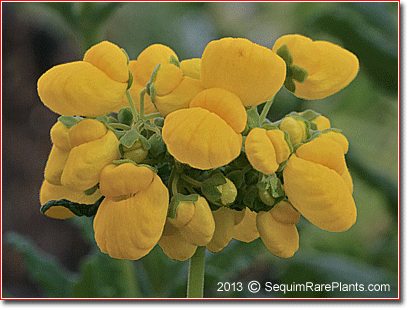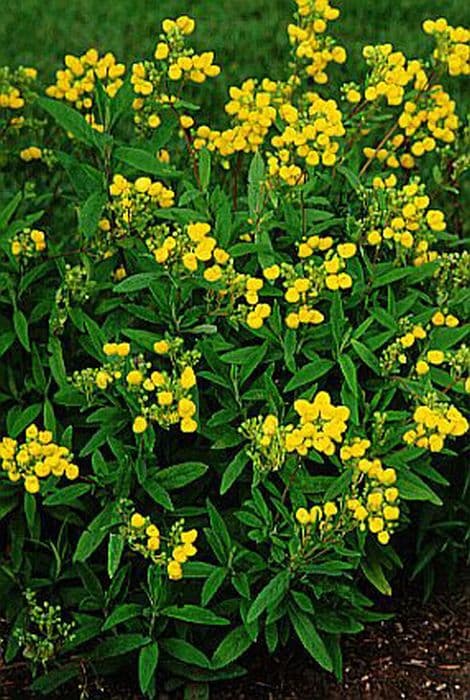Calceolaria Violacea Jovellana violacea

ABOUT
Jovellana violacea, commonly known as the calceolaria, is a visually striking plant primarily recognized for its unique and appealing flowers. The blooms are delicate and intriguing, with a two-lipped appearance that resembles small, dainty slippers. The upper lip of the flower is usually lightly colored, ranging from pale lilac to a soft violet, while the lower lip typically showcases deeper purple spots or markings, which add to the visual interest and contrast of the petals. These spots often create a speckled pattern that enhances the ornamental value of the plant. The leaves of the calceolaria are an attractive green, contributing to the lush appearance of the plant. They are commonly described as toothed or scalloped, with edges that are not smooth but rather gently jagged, giving them a slightly ruffled look. The foliage has a somewhat sticky texture and may have a fine, downy covering, which can be more prominent on the undersides. Overall, the calceolaria carries a soft, rounded form, with its foliage and blossoms creating a pleasing, bushy appearance. The contrast between its vivid flowers and verdant leaves makes it a popular choice in gardens and as houseplants for those who wish to add a touch of whimsy and color to their surroundings. The lively appearance of the calceolaria's blooms is particularly appreciated during its flowering season, as it brings energy and a bit of fantasy to the environment in which it grows.
About this plant
 Names
NamesSynonyms
Calceolaria, Teacup Flower, Violet Jovellana
Common names
Calceolaria violacea, Jovellana punctata.
 Toxicity
ToxicityTo humans
Jovellana violacea, commonly known as Calceolaria, is not widely recognized for its toxicity to humans, and there is limited information regarding its potential poisonous properties. However, many plants contain compounds that can be irritating or harmful if ingested. Without specific toxicity information for this plant, it would be prudent to avoid ingestion and handle it with care. If you suspect poisoning from any plant, including Calceolaria, seek medical attention immediately. Symptoms of general plant poisoning may include nausea, vomiting, diarrhea, abdominal pain, and in severe cases, breathing difficulties, or an irregular heartbeat.
To pets
Calceolaria is not commonly known to be toxic to pets, but as with many household plants, there is often a lack of extensive research on their effects on animals. In general, different pets can react differently to various plants, with symptoms ranging from mild gastrointestinal upset to more serious conditions if toxic compounds are present. To err on the side of caution, keep Calceolaria out of reach of pets. If you suspect your pet has ingested part of this plant, monitor for signs of distress such as vomiting, diarrhea, salivation, or lack of appetite and consult your veterinarian promptly for guidance.
 Characteristics
CharacteristicsLife cycle
Perennials
Foliage type
Evergreen
Color of leaves
Green
Flower color
Purple
Height
2 feet (0.61 meters)
Spread
2 feet (0.61 meters)
Plant type
Shrub
Hardiness zones
8
Native area
Chile
Benefits
 General Benefits
General Benefits- Ornamental Value: Jovellana violacea, commonly known as the "teacup flower," adds aesthetic beauty to gardens with its delicate purple and white flowers.
- Habitat for Wildlife: The teacup flower provides nectar for pollinators such as bees and butterflies, contributing to a biodiverse ecosystem.
- Low Maintenance: Teacup flowers are known for being relatively easy to care for, requiring minimal maintenance once established.
- Seasonal Interest: It has a long flowering season, offering visual interest in the garden for an extended period.
- Container Gardening: Because of its size, Jovellana violacea is well-suited for container gardening, making it a versatile plant for patios and balconies.
- Border Plant: It can be used effectively as a border plant because of its compact size and appealing color contrast.
- Tolerance to Mildew: The teacup flower is noted for its resistance to powdery mildew, making it a good choice for gardeners who face issues with this common plant disease.
- Herbaceous Perennial: As a perennial, it will regrow every year without needing to be replanted, which is convenient and cost-effective for gardeners.
- Shade Tolerance: The plant can tolerate partial shade, thus it can grow well in various light conditions, which is ideal for gardens with variable shade patterns.
- Cut Flowers: The attractive blooms of the teacup flower can also be used for cut flower arrangements indoors.
 Medical Properties
Medical PropertiesThis plant is not used for medical purposes.
 Air-purifying Qualities
Air-purifying QualitiesThis plant is not specifically known for air purifying qualities.
 Other Uses
Other Uses- Jovellana violacea, commonly known as the Calceolaria Mexican Slipper Plant, is occasionally used in arts and crafts due to its unique blossom shape which can inspire designs or be integrated into floral arrangements.
- The plant's vibrant and speckled flowers make it an attractive motif for textiles, such as prints for fabrics and clothing, adding a natural and whimsical flair to designs.
- In educational settings, the Mexican Slipper Plant can serve as a subject for botanical studies due to its interesting floral structure and pollination biology.
- The contrasting colors of its flowers can be used as a natural dye source for small-scale textile dyeing projects.
- Gardeners might employ Jovellana violacea as a teaching tool for children, illustrating the diversity of plant life and nurturing an interest in horticulture.
- Its attractive appearance lends itself to being used in photography and painting as a subject for artists seeking to capture the beauty of unique flowers.
- The plant can be used as a natural decoration for themed events, particularly in garden parties or other outdoor festivities.
- Due to its distinctive look, the plant may inspire jewelry designs, with artisans replicating its flowers in metals, stones, or other materials.
- Jovellana violacea can play a role in ecological landscaping, supporting efforts to establish visually stimulating and biodiverse gardens.
- Lastly, the plant can contribute to the habitat garden, providing shelter and resources for pollinators like bees and butterflies, which are essential for a healthy ecosystem.
Interesting Facts
 Feng Shui
Feng ShuiThe Calceolaria is not used in Feng Shui practice.
 Zodiac Sign Compitability
Zodiac Sign CompitabilityThe Calceolaria is not used in astrology practice.
 Plant Symbolism
Plant Symbolism- Celebration: The name 'Jovellana' is reminiscent of the Roman god Jove, commonly identified with Jupiter, who was associated with festivities and celebrations. Jovellana violacea's vibrant purple flowers capture this sense of joy and festivity.
- Uniqueness: Jovellana violacea, commonly known as the calico flower, has distinctive spotted and colored patterns on its blooms that signify uniqueness and the appreciation of diversity.
- Subtle Beauty: With its smaller, delicate flowers and soft purple hues, the calico flower can represent the understated beauty found in simplicity and the quiet moments of life.
- Mystery: The purple color and intriguing patterns on the petals of the calico flower can also symbolize mystery and the unknown, inviting onlookers to look closer and discover its secrets.
- Adaptability: As the calico flower thrives in various conditions from sun to partial shade, it can represent adaptability and the ability to thrive in different environments and life circumstances.
 Water
WaterThe Jovellana violacea, also known as the teacup flower or teacup plant, requires regular watering to maintain consistent soil moisture, especially during its growing season in spring and summer. It should be watered once or twice a week, depending on the climate and the environment it's placed in; hotter, dryer conditions may require more frequent watering. The method of watering should gently saturate the soil without flooding it, using approximately 16 to 32 ounces of water, ensuring the pot has adequate drainage to avoid waterlogging. During winter, watering can be reduced to every other week as plant growth slows and evaporation rates decrease.
 Light
LightThe teacup flower thrives best in bright, indirect sunlight. It should be placed in a location where it can receive plenty of light without being exposed to the harsh afternoon sun, which could damage the foliage. An east-facing window or a spot that gets filtered light through light curtains is ideal for the teacup flower to grow strong and healthy.
 Temperature
TemperatureThe teacup flower prefers temperate conditions and does well in average room temperatures between 60 and 75 degrees Fahrenheit, avoiding any sudden temperature changes. It can survive short-term temperatures as low as 50 degrees Fahrenheit but should be protected from frost and extreme cold. The teacup flower will thrive year-round if these temperature conditions are consistently maintained.
 Pruning
PruningPruning the teacup flower is essential to encourage bushier growth and remove any dead or wilted leaves and stems. It's best to prune the plant in the spring before the new growth begins. Light pruning can be done periodically throughout the growing season to shape the plant and improve its overall appearance.
 Cleaning
CleaningAs needed
 Soil
SoilThe Teacup Flower thrives in well-draining soil with good organic matter content. The best soil mix is one part peat, one part pine bark, and one part coarse sand or perlite. The ideal pH for the Teacup Flower is slightly acidic to neutral, ranging from 6.0 to 7.0.
 Repotting
RepottingTeacup Flowers should be repotted every 2-3 years or when they outgrow their pots. It's best to repot in spring before new growth begins.
 Humidity & Misting
Humidity & MistingTeacup Flower prefers high humidity levels, ideally between 60-80%. It thrives in a humid environment that simulates its native habitat.
 Suitable locations
Suitable locationsIndoor
Place in bright, indirect light and maintain humidity.
Outdoor
Part shade, shelter from strong winds, high humidity.
Hardiness zone
9-11 USDA
 Life cycle
Life cycleJovellana violacea, commonly known as Calceolaria, begins its life cycle as a seed that requires well-drained soil and dappled light for germination. After sprouting, it enters a vegetative stage characterized by the growth of its distinctive serrated green leaves and the development of a strong root system. This perennial matures and enters the flowering stage, producing delicate violet or white flowers with a spotted throat, typically in late spring to summer. Following pollination, the flowers will produce small capsules filled with seeds, completing the reproductive stage. After seed dispersal, the plant may experience a period of dormancy, especially in cooler climates. Throughout its life, the Calceolaria requires consistently moist soil and protection from intense direct sunlight to thrive and repeat its life cycle annually.
 Propogation
PropogationPropogation time
Spring-Early Summer
The Tear Drop Bush (Jovellana violacea) is commonly propagated through seed sowing. The best time to propagate this species through seeds is typically in the spring, when temperatures are mild and the risk of frost has passed. To propagate by seed, one would first collect the seeds from the mature pods on the plant. These seeds should then be sown in a well-draining seed starting mix, lightly covered with soil, and kept moist. It is important to maintain a consistent temperature between 65-75 degrees Fahrenheit (18-24 degrees Celsius) for optimal germination, which may take several weeks. Once seedlings emerge and are large enough to handle, they can be transplanted into individual pots and gradually acclimatized to outdoor conditions before planting out in their final location.

